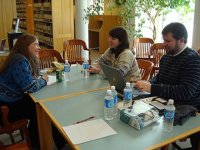Collaboration, Change and Innovation in Teaching and Learning
Change is becoming a constant in St. John the Baptist Parish Public Schools, located along the Mississippi River west of New Orleans.
Like many other states, Louisiana is preparing to implement the Common Core State Standards, along with Compass, a new evaluation rubric that applies a magnifying glass to the nuts and bolts of teaching practice. And in St. John the Baptist Parish, teachers and school leaders are being asked to make these changes a reality while facing declining budgets, a continued recovery from 2012's Hurricane Isaac, and persistent poverty -- nearly nine in ten of the district's students qualify for free and reduced lunch.
The district’s vision is to work "as one" to meet the community's education needs, and in St. John, that's more than just empty talk. Last year, school leaders and teachers came together seeking ways to give teachers the time for working and learning with their peers toward solutions that would improve classroom teaching and, by extension, student achievement. The result was a lengthened school day -- and a renewed sense of professionalism among the district's teachers, who put the needs of children first and are equal partners implementing wide-ranging reforms that will enhance teaching and learning practices.
Familiar Elements in a New Model
While "collaboration" within schools has become an education buzzword, across the country, teacher unions and districts large and small are also working together in ways that many once believed were not possible because of the traditional, often antagonistic labor-management relationship. Unions and district leaders are sitting down at the table not just to air grievances or negotiate contracts, but to work through the big decisions needed to bring about meaningful improvement.
There’s a growing understanding that the classroom teacher's voice and expertise is vital to coming up with solutions that actually work in schools. Much of our efforts at the NEA Foundation have been on finding ways to support local teacher unions and their school districts as they work together to leverage that expertise to benefit everyone -- schools, teachers, students and the community. Our Institute for Innovation in Teaching and Learning, in which St. John will participate, has supported a network of 18 of these union-district collaborations nationwide by providing ongoing coaching, leadership development, technical assistance and opportunities to share what works with peers across the country, and to help school administrators and teachers become not just better leaders, but better collaborators. Much as leadership skills must be developed over time, even seasoned educators must learn how to work together in new ways.
Already these kinds of collaborations have led to once-unthinkable results. Growing numbers of districts across the country now include programs in which teachers support their new and struggling peers and ultimately evaluate their performance with the focus on having a strong teacher in every classroom. Others have created professional development programs to introduce more equitable teaching practices and implement new curricula. In places like Jefferson County, Colorado, both teachers and district leaders were willing to rethink longstanding notions about teacher compensation to develop a new system that values teachers as leaders. In Seattle, Washington and Springfield, Massachusetts, teachers have gone out of their comfort zones by getting to know their students' families and circumstances through home visits that have changed the parent-teacher dynamic for the better. And in Fayette County, Kentucky, teachers and district officials held community meetings to identify real solutions for a rapidly changing student population.
A Growing Network
Along with St. John, four other districts -- in Clark County, Nevada; Durango, Colorado; West Springfield, Massachusetts; and San Antonio, Texas -- are joining our Institute network this fall. In each, teachers and administrators have already shown a willingness to work together, and are acting with a sense of urgency around their most critical needs. In San Antonio, for example, the teacher union and district are responding to changing student needs by exploring the possibility of a teacher-led public charter, as well as rethinking professional learning for all educators.
Collaboration on its own doesn't guarantee results, but management research shows that when professionals work together in close partnership toward common goals and when decisions are made with the expertise of those closest to the point of impact, the conditions are right for progress. Collaboration will result in improvements "where it matters most -- in the classroom," says St. John Superintendent Kevin George. "Staff and students will benefit as the information shared will have long-lasting effects," adds St. John Education Association President Iona Holloway. I couldn't agree more, and I hope that in districts across the country, more and more officials will work with teachers to bring about the changes our schools need.
